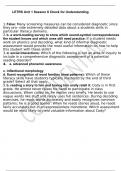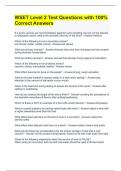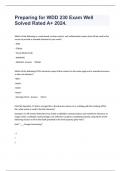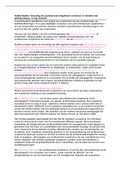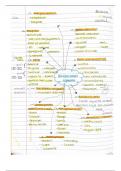Module 4: Mental Healthcare and Research
The Empirical Status of Empirically
Supported Psychotherapies
(Westen et. al., 2004)
What are the assumptions underlying Empirically Supported Psychotherapies, as discussed
by Westen et al. (2004)?
There are four assumptions underlying ESPs – including:
1) Psychopathology is highly malleable
2) Most patients can be treated for a single problem or disorder
3) Psychiatric disorders can be treated independently of personality factors unlikely to
change in brief treatments
4) Experimental methods provide a gold standard for identifying useful
psychotherapeutic packages
THE ASSUMPTIONS OF ESPs
Psychological Processes The assumption of malleability is implicit in the treatment lengths used in almost
are Highly Malleable all ESPs
This assumption of malleability has come about as a result of efforts to
standardize
The exclusive focus on brief treatments emerged due to pragmatic
considerations such as the need to avoid the confound of time passed when
comparing psychotherapies with medications
The longer the therapy – the more variability within experimental conditions
The more variability – the less one can draw causal conclusions
The preference for brief treatments is a natural consequence of efforts to
standardize treatments to bring them under experimental control
Most Patients Have One The assumption that patients can be treated as if they have one primary, discrete
Primary Problem or Can problem – and the correlative assumption that if they have more than one disorder
,be Treated as if They Do – the syndromes can be treated sequentially using different manuals
Reflects an admixture of methodological constraints and theoretical meta-
assumptions
Including patients with substantial comorbidities would increase the sample size
needed to detect treatment differences – leading to using ‘pure’ samples to avoid
confounds presented by co-occurring disorders
The requirement that research proposals must be tied to categories defined by the
DSM in order to receive funding – has guaranteed a focus on single disorders or at
most dual diagnoses
Psychological Symptoms The assumption that psychological syndromes can be understood and treated in
can be Understood and isolation from the personality of the person who bares them – is essential to the
Treated in Isolation from methodology of ESPs – due to the brief, focal nature of treatment required to
Personality Dispositions maximize experimental control
As well as due to the focus on syndromes – rather than processes or diatheses
Controlled Clinical Trials The most central assumption underlying the establishing ESTs – is that RCT
Provide the Gold Standard methodology provides a gold standard for assessing the efficacy of interventions
for Assessing Therapeutic The aim of manualization is standardization of the intervention across participants
Efficacy – and the control of potential confounding variables
Assume that elements of efficacious treatment are dissociable and subject to
dismantling (= most readily applied to brief treatments with highly specific
procedures where one can adhere closely to the manual and include or exclude
certain set of interventions)
The selection of treatments to test and compare is a source of bias – as the
methodology of EST requires brevity and experimental control which precludes the
testing of treatments widely used in the community
How can they be violated?
, Syndromes that have more generalized affect states – violate all of the EST assumptions –
as they are:
1. Highly resistant to change
2. Associated with high comorbidity
3. Strongly associated with enduring personality dispositions
4. And efficacy trials testing treatments for them have required secondary correlational
analyses to interpret the findings
Brief manualized treatments for such disorders – tend to fail to produce sustained recovery
The assumptions are also violated by treatments which introduce too much within-condition
variability – such as treatments that:
1. Require principle-based – rather than intervention-based manualization
2. Prescribe a large set of interventions from which clinicians must choose on the basis
of the material the patient presents
3. Allow the patient to structure the session
Psychopathological Processes are Highly Malleable
Malleability is For some disorders, brief and focal treatments do produce powerful results
Inconsistent with High However, with or without treatment – relapse rates for most disorders are high
Relapse Rates which is inconsistent with the malleability assumption
Malleability is The assumption is inconsistent with data from naturalistic studies of psychotherapy
Inconsistent with Dose- which consistently find a dose-response relationship
Response Relationships Such that longer treatments are more effective than briefer treatments
Enduring rehabilitation requires substantially longer treatment – depending on
patient’s degree and type of impairment
Malleability is Data on ESTs for a range of disorders – using outcome intervals longer than 6
Inconsistent with Data months – suggest:
from Controlled Trials (1) that most psychopathological vulnerabilities are highly resistant to change
(2) that many are rooted in personality and temperament
(3) that the modal patient treated with brief treatments for most disorders –
relapses or seeks additional treatment within 12-24 months
Malleability is Research using implicit measures often finds continued biases among those who
,Inconsistent with Implicit are no longer depressed
and Indirect Measures Suggesting that changes in state may or may not be accompanied by changes in
diatheses for those states
Raises questions about the durability of change
Most Patients Have One Primary Problem or Can Be Treated as if They Do
Empirical and Pragmatic DSM diagnoses are created on the basis of the available evidence rather than
Limits Imposed by strictly empirical methods – some categories are not well supported and relying on
Reliance on DSM them may result in a range of unsupported assumptions about psychopathology
Diagnoses The implicit assumption that patients usually present with symptoms of a specific
Axis I diagnosis and can identify precisely which one it is at the start of treatment –
is invalid
The sheer number of disorders in the DSM renders the notion of clinicians learning
disorder-specific manuals for more than a handful of disorders unrealistic –
clinicians would have to learn 2-3 manuals for each disorder
The Problem of Single-disorder presentations are the exception rather than the rule
Comorbidity Comorbidity has been viewed as being random or additive and argued that
comorbid presentation should be approached using sequential manuals
Sequential symptom targeting may not be optimal under conditions in which:
(1) Distinct Axis I symptoms reflect common underlying causes
(2) Axis I symptoms arise in the context of enduring personality patterns that create
psychosocial vulnerabilities to future episodes
(3) the presence of multiple symptoms can have emergent properties not reducible
to the characteristics of each symptom independently
Limits on Generalizability Clinicians in studies assessing the efficacy of ESTs usually do not conduct their
own evaluation – and proceed on the assumption that the diagnosis is accurate and
primary
The function of assessing comorbid conditions in the lab is to eliminate patients
who do not meet study criteria
The clinician may not even be aware that the patient has a secondary diagnosis
In clinical practice – clinicians do not assume that one syndrome or symptom is
primary
, This entails developing a tentative case formulation – which is likely to be more
varied that then standardized formulations which are crucial in research to
minimize variation
Psychological Symptoms can be Understood and Treated in Isolation from
Personality Dispositions
Independence of Most Axis I syndromes are not independent of personality and personality often
Symptoms and Personality moderates treatment response
Processes Different kinds of personality diatheses predispose different individuals to become
depressed under different circumstances
Axis I anxiety and mood disorders are systematically related to variables
considered personality traits – e.g., high negative and low positive affect
The presence of multiple Axis I conditions is a proxy for the presence of an Axis II
condition
The same Axis I symptom may have different functions or implications iin the
presence of certain kinds of personality disturbance
The Paradox of Pure Including patients who share a diagnosis but vary considerably in personality –
Samples would require using samples sizes that are sig larger than customary or tenable for
establishing ESTs
If researchers include patients with substantial personality pathology in clinical
trials – they run the risk of ambiguous conclusions if these variable moderate
outcome
If they exclude such patients – one cannot assume generalizability to a target
population – which is rarely symptomatically pure
Controlled Clinical Trials Provide the Gold Standard for Assessing Therapeutic
Efficacy
The Functions of The extent to which a treatment requires a competent clinical decision-maker is the
Manualization extent to which that treatment will not be able to come under experimental control
in the lab
This places a focus on development of treatment packages that minimize clinical
judgement – and in clinical practice, the clinician must adhere closely to the
The Empirical Status of Empirically
Supported Psychotherapies
(Westen et. al., 2004)
What are the assumptions underlying Empirically Supported Psychotherapies, as discussed
by Westen et al. (2004)?
There are four assumptions underlying ESPs – including:
1) Psychopathology is highly malleable
2) Most patients can be treated for a single problem or disorder
3) Psychiatric disorders can be treated independently of personality factors unlikely to
change in brief treatments
4) Experimental methods provide a gold standard for identifying useful
psychotherapeutic packages
THE ASSUMPTIONS OF ESPs
Psychological Processes The assumption of malleability is implicit in the treatment lengths used in almost
are Highly Malleable all ESPs
This assumption of malleability has come about as a result of efforts to
standardize
The exclusive focus on brief treatments emerged due to pragmatic
considerations such as the need to avoid the confound of time passed when
comparing psychotherapies with medications
The longer the therapy – the more variability within experimental conditions
The more variability – the less one can draw causal conclusions
The preference for brief treatments is a natural consequence of efforts to
standardize treatments to bring them under experimental control
Most Patients Have One The assumption that patients can be treated as if they have one primary, discrete
Primary Problem or Can problem – and the correlative assumption that if they have more than one disorder
,be Treated as if They Do – the syndromes can be treated sequentially using different manuals
Reflects an admixture of methodological constraints and theoretical meta-
assumptions
Including patients with substantial comorbidities would increase the sample size
needed to detect treatment differences – leading to using ‘pure’ samples to avoid
confounds presented by co-occurring disorders
The requirement that research proposals must be tied to categories defined by the
DSM in order to receive funding – has guaranteed a focus on single disorders or at
most dual diagnoses
Psychological Symptoms The assumption that psychological syndromes can be understood and treated in
can be Understood and isolation from the personality of the person who bares them – is essential to the
Treated in Isolation from methodology of ESPs – due to the brief, focal nature of treatment required to
Personality Dispositions maximize experimental control
As well as due to the focus on syndromes – rather than processes or diatheses
Controlled Clinical Trials The most central assumption underlying the establishing ESTs – is that RCT
Provide the Gold Standard methodology provides a gold standard for assessing the efficacy of interventions
for Assessing Therapeutic The aim of manualization is standardization of the intervention across participants
Efficacy – and the control of potential confounding variables
Assume that elements of efficacious treatment are dissociable and subject to
dismantling (= most readily applied to brief treatments with highly specific
procedures where one can adhere closely to the manual and include or exclude
certain set of interventions)
The selection of treatments to test and compare is a source of bias – as the
methodology of EST requires brevity and experimental control which precludes the
testing of treatments widely used in the community
How can they be violated?
, Syndromes that have more generalized affect states – violate all of the EST assumptions –
as they are:
1. Highly resistant to change
2. Associated with high comorbidity
3. Strongly associated with enduring personality dispositions
4. And efficacy trials testing treatments for them have required secondary correlational
analyses to interpret the findings
Brief manualized treatments for such disorders – tend to fail to produce sustained recovery
The assumptions are also violated by treatments which introduce too much within-condition
variability – such as treatments that:
1. Require principle-based – rather than intervention-based manualization
2. Prescribe a large set of interventions from which clinicians must choose on the basis
of the material the patient presents
3. Allow the patient to structure the session
Psychopathological Processes are Highly Malleable
Malleability is For some disorders, brief and focal treatments do produce powerful results
Inconsistent with High However, with or without treatment – relapse rates for most disorders are high
Relapse Rates which is inconsistent with the malleability assumption
Malleability is The assumption is inconsistent with data from naturalistic studies of psychotherapy
Inconsistent with Dose- which consistently find a dose-response relationship
Response Relationships Such that longer treatments are more effective than briefer treatments
Enduring rehabilitation requires substantially longer treatment – depending on
patient’s degree and type of impairment
Malleability is Data on ESTs for a range of disorders – using outcome intervals longer than 6
Inconsistent with Data months – suggest:
from Controlled Trials (1) that most psychopathological vulnerabilities are highly resistant to change
(2) that many are rooted in personality and temperament
(3) that the modal patient treated with brief treatments for most disorders –
relapses or seeks additional treatment within 12-24 months
Malleability is Research using implicit measures often finds continued biases among those who
,Inconsistent with Implicit are no longer depressed
and Indirect Measures Suggesting that changes in state may or may not be accompanied by changes in
diatheses for those states
Raises questions about the durability of change
Most Patients Have One Primary Problem or Can Be Treated as if They Do
Empirical and Pragmatic DSM diagnoses are created on the basis of the available evidence rather than
Limits Imposed by strictly empirical methods – some categories are not well supported and relying on
Reliance on DSM them may result in a range of unsupported assumptions about psychopathology
Diagnoses The implicit assumption that patients usually present with symptoms of a specific
Axis I diagnosis and can identify precisely which one it is at the start of treatment –
is invalid
The sheer number of disorders in the DSM renders the notion of clinicians learning
disorder-specific manuals for more than a handful of disorders unrealistic –
clinicians would have to learn 2-3 manuals for each disorder
The Problem of Single-disorder presentations are the exception rather than the rule
Comorbidity Comorbidity has been viewed as being random or additive and argued that
comorbid presentation should be approached using sequential manuals
Sequential symptom targeting may not be optimal under conditions in which:
(1) Distinct Axis I symptoms reflect common underlying causes
(2) Axis I symptoms arise in the context of enduring personality patterns that create
psychosocial vulnerabilities to future episodes
(3) the presence of multiple symptoms can have emergent properties not reducible
to the characteristics of each symptom independently
Limits on Generalizability Clinicians in studies assessing the efficacy of ESTs usually do not conduct their
own evaluation – and proceed on the assumption that the diagnosis is accurate and
primary
The function of assessing comorbid conditions in the lab is to eliminate patients
who do not meet study criteria
The clinician may not even be aware that the patient has a secondary diagnosis
In clinical practice – clinicians do not assume that one syndrome or symptom is
primary
, This entails developing a tentative case formulation – which is likely to be more
varied that then standardized formulations which are crucial in research to
minimize variation
Psychological Symptoms can be Understood and Treated in Isolation from
Personality Dispositions
Independence of Most Axis I syndromes are not independent of personality and personality often
Symptoms and Personality moderates treatment response
Processes Different kinds of personality diatheses predispose different individuals to become
depressed under different circumstances
Axis I anxiety and mood disorders are systematically related to variables
considered personality traits – e.g., high negative and low positive affect
The presence of multiple Axis I conditions is a proxy for the presence of an Axis II
condition
The same Axis I symptom may have different functions or implications iin the
presence of certain kinds of personality disturbance
The Paradox of Pure Including patients who share a diagnosis but vary considerably in personality –
Samples would require using samples sizes that are sig larger than customary or tenable for
establishing ESTs
If researchers include patients with substantial personality pathology in clinical
trials – they run the risk of ambiguous conclusions if these variable moderate
outcome
If they exclude such patients – one cannot assume generalizability to a target
population – which is rarely symptomatically pure
Controlled Clinical Trials Provide the Gold Standard for Assessing Therapeutic
Efficacy
The Functions of The extent to which a treatment requires a competent clinical decision-maker is the
Manualization extent to which that treatment will not be able to come under experimental control
in the lab
This places a focus on development of treatment packages that minimize clinical
judgement – and in clinical practice, the clinician must adhere closely to the


